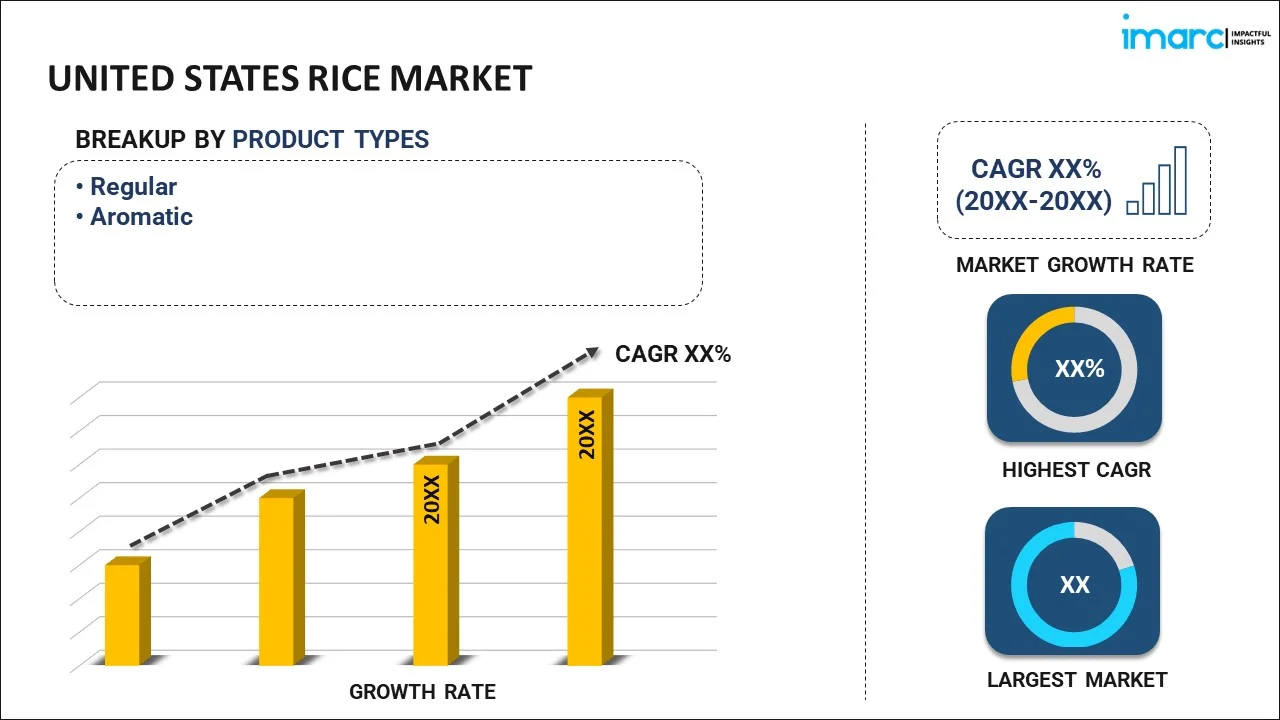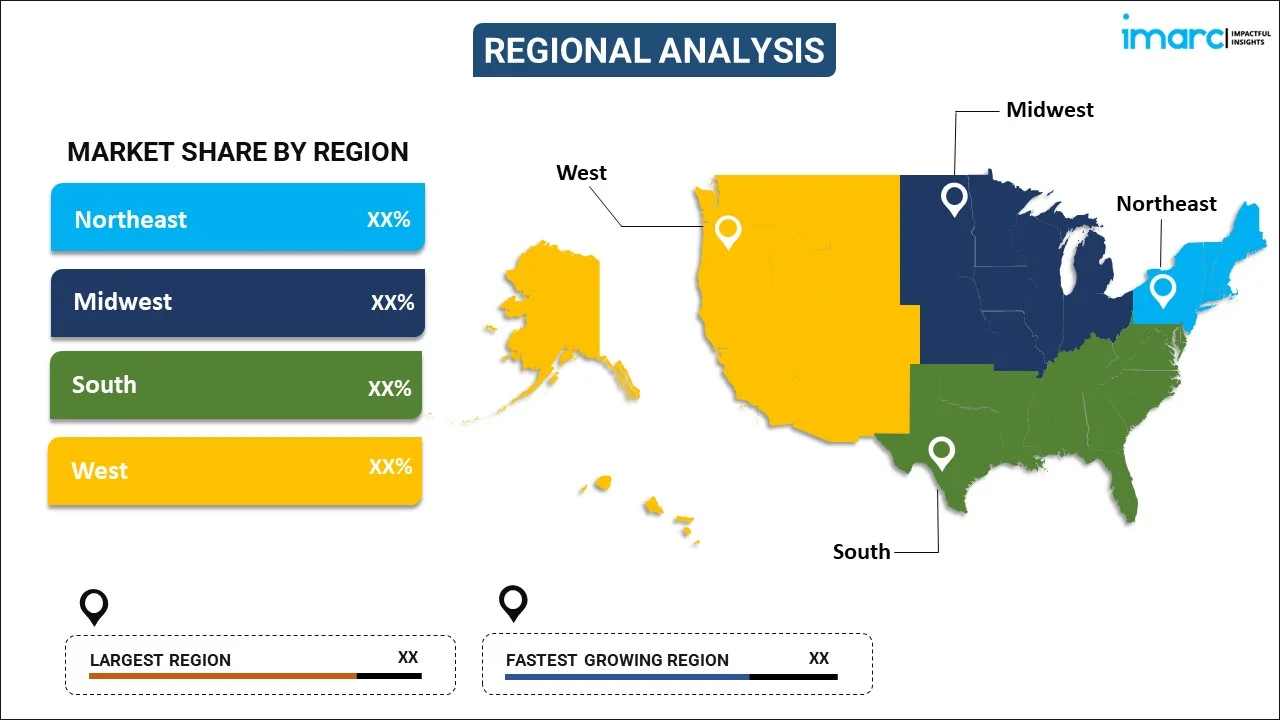
United States Rice Market Report by Product Type (Regular, Aromatic), Type (Red Rice, Arborio Rice, Black Rice, Grain Fragrance Rice, Brown Rice, Rosematta Rice, Grain Parboiled Rice, Sushi Rice, and Others), Grain Size (Long Grain, Medium Grain, Short Grain), Distribution Channel (Offline Stores, Online Stores), Application (Food, Feed, and Others), and Region 2025-2033
Market Overview:
The United States rice market size is projected to exhibit a growth rate (CAGR) of 2.40% during 2025-2033. The increasing consumption of rice as a staple food, changing dietary preferences and shifting demographics, the flourishing food processing industry, and the implementation of supportive policies by the Government of The United States of America represent some of the key factors driving the market.
|
Report Attribute
|
Key Statistics
|
|---|---|
|
Base Year
|
2024
|
|
Forecast Years
|
2025-2033
|
|
Historical Years
|
2019-2024
|
| Market Growth Rate 2025-2033 | 2.40% |
Rice is a cereal grain originating from two species, Oryza sativa (Asian rice) and Oryza glaberrima (African rice). It is available in different varieties, such as white, black, red, brown, and aromatic rice. The production of rice involves multiple steps encompassing land preparation, sowing, nurturing the crop, harvesting, and subsequent post-harvest management. Rice is a significant source of fiber and carbohydrates and contains other essential nutrients, including proteins, minerals, and vitamins. Its applications are extensive, ranging from culinary uses, animal feed, and brewing to flour production, bioplastics, biofuel, medicine, and personal care and cosmetics. In addition, it holds cultural significance in various traditions, playing an essential role in religious practices and ceremonies. Rice offers several health benefits, such as enhancing energy, regulating blood pressure, promoting metabolic functions, and aiding digestion. It is also an economical, gluten-free, and versatile product that is easy to prepare, increase satiety, lower sodium intake, and boasts a long shelf life.
United States Rice Market Trends:
The United States rice market is propelled by its increasing consumption as a staple food ingredient across a myriad of American cuisines. Furthermore, the rising product consumption due to changing dietary preferences and shifting demographics are contributing to the market growth. Moreover, the rising health consciousness among Americans is facilitating the demand for brown and wild rice, which are perceived as healthier alternatives. Additionally, the expanding food service sector, including restaurants, catering, and fast-food chains, is boosting the market growth. Apart from this, the flourishing food processing industry, which uses rice in a variety of products, such as baby foods, snacks, and beverages, is strengthening the market growth. Additionally, the recent technological advancements in agricultural practices, leading to higher yield varieties and more efficient farming methods, are catalyzing the market growth. In addition, the implementation of supportive policies by the Government of The United States of America to encourage the domestic production of rice and support the agriculture industry through subsidies and favorable trade policies are positively influencing the market growth. Besides this, the growing demand for organic rice due to increasing consumer inclination towards natural and non-GMO food products is propelling the market growth. Moreover, the easy product availability across online and offline retail chains, which provides easy accessibility and enhances convenience, is favoring the market growth. Other factors, including rising demand for exotic rice-based cuisines, extensive research and development (R&D) activities, and the growing consumption of premium rice varieties, are anticipated to drive the market growth.
Key Market Segmentation:
IMARC Group provides an analysis of the key trends in each segment of the United States rice market report, along with forecasts at the country level for 2025-2033. Our report has categorized the market based on product type, type, grain size, distribution channel, and application.
Product Type Insights:

- Regular
- Aromatic
The report has provided a detailed breakup and analysis of the market based on the product type. This includes regular and aromatic.
Type Insights:
- Red Rice
- Arborio Rice
- Black Rice
- Grain Fragrance Rice
- Brown Rice
- Rosematta Rice
- Grain Parboiled Rice
- Sushi Rice
- Others
The report has provided a detailed breakup and analysis of the market based on the type. This includes red rice, arborio rice, black rice, grain fragrance rice, brown rice, rosematta rice, grain parboiled rice, sushi rice, and others.
Grain Size Insights:
- Long Grain
- Medium Grain
- Short Grain
The report has provided a detailed breakup and analysis of the market based on the grain size. This includes long, medium, and short grain.
Distribution Channel Insights:
- Offline Stores
- Online Stores
The report has provided a detailed breakup and analysis of the market based on the distribution channel. This includes offline and online stores.
Application Insights:
- Food
- Feed
- Others
The report has provided a detailed breakup and analysis of the market based on the application. This includes food, feed, and others.
Regional Insights:

- Northeast
- Midwest
- South
- West
The report has also provided a comprehensive analysis of all the major regional markets, which include Northeast, Midwest, South, and West.
Competitive Landscape:
The report has also provided a comprehensive analysis of the competitive landscape in the market. Competitive analysis such as market structure, key player positioning, top winning strategies, competitive dashboard, and company evaluation quadrant has been covered in the report. Also, detailed profiles of all major companies have been provided.
United States Rice Market Report Coverage:
| Report Features | Details |
|---|---|
| Base Year of the Analysis | 2024 |
| Historical Period | 2019-2024 |
| Forecast Period | 2025-2033 |
| Units | Billion USD |
| Scope of the Report | Exploration of Historical and Forecast Trends, Industry Catalysts and Challenges, Segment-Wise Historical and Predictive Market Assessment:
|
| Product Types Covered | Regular, Aromatic |
| Types Covered | Red Rice, Arborio Rice, Black Rice, Grain Fragrance Rice, Brown Rice, Rosematta Rice, Grain Parboiled Rice, Sushi Rice, Others |
| Grain Sizes Covered | Long Grain, Medium Grain, Short Grain |
| Distribution channels Covered | Offline Stores, Online Stores |
| Applications Covered | Food, Feed, Others |
| Regions Covered | Northeast, Midwest, South, West |
| Customization Scope | 10% Free Customization |
| Post-Sale Analyst Support | 10-12 Weeks |
| Delivery Format | PDF and Excel through Email (We can also provide the editable version of the report in PPT/Word format on special request) |
Key Questions Answered in This Report:
- How has the United States rice market performed so far and how will it perform in the coming years?
- What has been the impact of COVID-19 on the United States rice market?
- What is the breakup of the United States rice market on the basis of product type?
- What is the breakup of the United States rice market on the basis of type?
- What is the breakup of the United States rice market on the basis of grain size?
- What is the breakup of the United States rice market on the basis of distribution channel?
- What is the breakup of the United States rice market on the basis of application?
- What are the various stages in the value chain of the United States rice market?
- What are the key driving factors and challenges in the United States rice market?
- What is the structure of the United States rice market and who are the key players?
- What is the degree of competition in the United States rice market?
Key Benefits for Stakeholders:
- IMARC’s report offers a comprehensive quantitative analysis of various market segments, historical and current market trends, market forecasts, and dynamics of the United States rice market from 2019-2033.
- The research study provides the latest information on the market drivers, challenges, and opportunities in the United States rice market.
- Porter's five forces analysis assist stakeholders in assessing the impact of new entrants, competitive rivalry, supplier power, buyer power, and the threat of substitution. It helps stakeholders to analyze the level of competition within the United States rice industry and its attractiveness.
- Competitive landscape allows stakeholders to understand their competitive environment and provides an insight into the current positions of key players in the market.
Need more help?
- Speak to our experienced analysts for insights on the current market scenarios.
- Include additional segments and countries to customize the report as per your requirement.
- Gain an unparalleled competitive advantage in your domain by understanding how to utilize the report and positively impacting your operations and revenue.
- For further assistance, please connect with our analysts.
 Inquire Before Buying
Inquire Before Buying
 Speak to an Analyst
Speak to an Analyst
 Request Brochure
Request Brochure
 Request Customization
Request Customization




.webp)




.webp)












